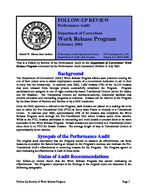FOLLOW-UP REVIEW
Performance Audit
Department of Corrections
Work Release Program
February 2004
Russell W. Hinton, State Auditor
Performance Audit Operations Division 254 Washington St., S.W.
Department of Audits and Accounts
Atlanta, GA 30334-8400
This is a Follow-up Review of the Performance Audit on the Department of Corrections' Work Release Program conducted by the Performance Audit Operations Division in July 2001.
Background
The Department of Corrections' (DOC) Work Release Program allows state prisoners nearing the end of their prison term to obtain employment outside of a correctional institution to aid in their re-entry into the community. In calendar year 2002, 1,085 inmates (7%) of the 16,124 inmates that were released from Georgia prisons successfully completed the Program. Program participants are assigned to one of eight community-based Transitional Centers (seven for males, one for females). The Transitional Centers are minimum-security, residential facilities that provide education and counseling programs to residents. Inmates can be referred to the Program by the State Board of Pardons and Paroles or by a DOC institution.
Once the DOC approves a referral to the Program, male inmates are placed on a waiting list to be sent to either the Pre-Transitional Unit (PTU) at Autry State Prison or directly to a Transitional Center. In calendar year 2002, approximately 54% of the inmates that completed the Work Release Program went through the Pre-Transitional Unit where inmates spend three months. While at the PTU, inmates participate in counseling and work details to prepare them to be more successful in the Work Release Program. Female inmates are sent directly to a Transitional Center since there is no PTU for female inmates. The average length of stay at Transitional Centers is approximately seven months.
Synopsis of the Performance Audit
The original audit determined that the Program needed to measure its effectiveness, use these measures to analyze the factors having an impact on the Program's success, and evaluate the PreTransitional Unit's effectiveness in screening inmates for the Program. The Program agreed to start evaluating its effectiveness in each of these areas.
Status of Audit Recommendations
Our follow-up review found that the Work Release Program has started evaluating its effectiveness. The Program's responses to the findings in the original report are discussed in the following paragraphs.
Follow-Up Review of Work Release Program
Page 1
Recommendation in 2001: The Department of Corrections has agreed to measure the effectiveness of the Work Release Program by analyzing the return to prison rates and conviction rates of inmates who complete the Program.
Current Status: DOC has developed a methodology for measuring the effectiveness of the Work Release Program. The methodology compares return to prison rates and reconviction rates of Work Release graduates to a control group of direct release inmates with closely matched characteristics. DOC's effectiveness measures identified that Work Release graduates have consistently lower return to prison rates and reconviction rates than the control group. DOC intends to use this methodology to continue to monitor the effectiveness of the Program and to measure the impact of changes made to the Program.
Recommendation in 2001: The Department of Corrections has agreed to start analyzing the factors that they consider as having a significant impact on the success of the Work Release Program using the new effectiveness measures identified in the previous finding.
Current Status: The original audit identified the "participant selection process" and the "proximity of a Center to an inmate's home" as two major factors influencing participant success in the Program. Due to operational and budgetary constraints, DOC did not implement the electronic needs assessment tool for offender referral and placement in the Program that was anticipated to be implemented by the end of fiscal year 2002. DOC reported that it is planning to identify the attributes of successful Work Release graduates in order to provide more information on selection criteria to DOC personnel and personnel with the Board of Pardons and Paroles. DOC is requesting new Transitional Centers in areas of greatest need so more participants can be located closer to their homes. In addition, DOC is planning to develop information on the characteristics of inmates that do not need to be placed at centers close to their homes that can be used in placement decisions.
DOC is starting to identify and evaluate other factors that may have an impact on Program success through its "What Works" model program. This model program will focus on employment, substance abuse, education, family involvement, and self-improvement. Beginning in fiscal year 2005, the consultant for the "What Works" program will evaluate factors impacting Program success by comparing recidivism rates, as well as frequency of dismissals and disciplinary reports, for the two model Centers to the other Centers and to inmates released directly from prison.
Recommendation in 2001: The Department of Corrections has agreed to evaluate the effectiveness of its Pre-Transitional Unit (PTU) in screening inmates for the Work Release Program.
Current Status: DOC has measured the effectiveness of its PTU. DOC feels that the PTU has been effective in helping it evaluate higher risk inmates prior to placement in the Work Release Program. DOC identified that despite being higher risk inmates, PTU graduates are dismissed less often from the Work Release Program than inmates that did not go through the PTU. DOC feels that the PTU currently has sufficient capacity to screen the number of inmates that they consider to be high risk.
For additional information or to request a copy of the original report, please contact the Performance Audit Operations Division, at 404-657-5220 or see our website: http//www.audits.state.ga.us/internet/pao/rpt_main.html
Follow-Up Review of Work Release Program
Page 2
